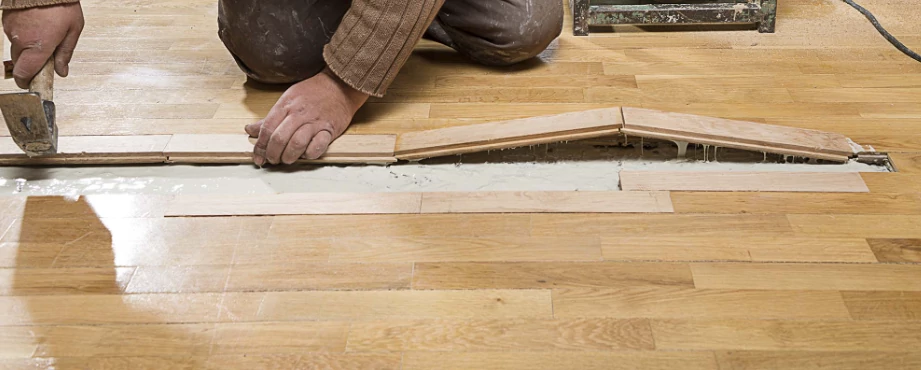Hardwood floors are a popular choice for many homeowners due to their timeless beauty and durability. However, even the most well-maintained floors may require repairs over time. Fortunately, many manufacturers offer warranties that cover certain types of hardwood floor repairs.
But what exactly is covered by these warranties? In this article, we will explore the different types of hardwood floor repairs typically covered by warranties and those that are not covered. By understanding your warranty, you can ensure that your hardwood floors remain in excellent condition for years to come.
When investing in hardwood flooring, it’s essential to understand the terms of your warranty fully. A warranty is a contract between you and the manufacturer outlining specific conditions under which they will repair or replace any defects in their product. Depending on the type of warranty you have, certain damages may be covered while others may not be included.
It’s crucial to know precisely what is and isn’t included in your warranty so that you can make informed decisions about maintenance and repairs over time. In this article, we’ll provide an overview of common manufacturing defects that are often covered by warranties as well as damages that aren’t typically included in the coverage.
Manufacturing Defects Covered by Warranties
Manufacturing defects that may be covered by warranties include issues related to wood quality, milling, and finishing processes. For instance, if the hardwood planks are warped or cracked due to poor drying methods during manufacturing, such a defect can be covered by the warranty.
Similarly, if the planks have knots or splits that were not disclosed in the product description or grading standards, this can also be considered a manufacturing defect.
Milling defects refer to issues with fitting and joining of the hardwood planks after installation. These may include uneven edges or grooves that do not align properly when two planks are joined together. Such defects can lead to gaps between the planks and affect their stability over time.
Finally, finishing defects relate to inconsistencies in color, gloss level, or protective coating applied on the surface of the hardwood floor. If there are areas where finish has flaked off or peeled away within a short period after installation, this could indicate a problem with application technique or quality control during manufacture.
All these types of manufacturing defects should be clearly defined in the warranty terms before purchasing a hardwood floor product.
Damages Not Covered by Warranties
Despite being promised a comprehensive guarantee, there are certain damages that fall outside the purview of warranties when it comes to repairing hardwood floors.
Typically, warranties do not cover damages caused by improper installation or maintenance, accidents, natural disasters, or wear and tear due to regular use.
For instance, if the hardwood floor is damaged due to water leakage from plumbing issues or flooding caused by natural disasters like hurricanes or earthquakes, it will not be covered under the warranty.
Similarly, scratches and dents resulting from furniture movement or pet activities may also not be included in the warranty.
It is vital for homeowners to read and understand their warranty agreements before making any claims as they differ based on manufacturers’ terms and conditions.
Understanding and Maintaining Your Warranty
The subtopic of understanding and maintaining your warranty is crucial in ensuring that you get the most out of your hardwood flooring investment.
Reading the fine print of your warranty can help you understand what repairs are covered and how to make a claim.
Proper maintenance, such as regular cleaning and avoiding excessive moisture, can also prolong the lifespan of your floors and prevent damage not covered by the warranty.
Additionally, knowing when to call for repairs can save you money in the long run and protect your floors from further damage.
Reading the Fine Print
One important aspect to consider when reviewing hardwood floor warranties is the need to read the fine print. This can provide crucial information regarding repairs and maintenance, which may not be covered under the warranty.
For example, some warranties only cover specific types of damages, while others may not cover damage caused by water or moisture.
Additionally, it is important to note that some warranties may require specific maintenance procedures in order for them to remain valid. Failure to follow these procedures could result in voiding the warranty altogether.
It is also recommended that homeowners keep records of any maintenance performed on their hardwood floors, as this can assist with potential warranty claims in the future.
By thoroughly reading and understanding the fine print of a hardwood floor warranty, homeowners can ensure they are aware of what repairs are covered and how best to maintain their flooring investment.
Proper Maintenance for Longevity
Properly maintaining a hardwood floor is crucial to its longevity. This includes regular cleaning and avoiding harsh chemicals that can damage the finish or stain the wood.
Vacuuming or sweeping regularly can help remove dirt and debris that can scratch the surface of the floor. It’s also important to promptly clean up any spills or stains to prevent them from seeping into the wood and causing permanent damage.
In addition, it’s recommended to use furniture pads under heavy furniture and avoid walking on the floors with high heels or cleats. Humidity levels should also be monitored, as excessive moisture can cause warping or cupping of the planks.
By following these maintenance guidelines, homeowners can extend the life of their hardwood floors and ensure they remain in good condition for years to come.
Knowing When to Call for Repairs
Recognizing signs of damage or wear and tear on a hardwood floor is crucial in knowing when to seek professional repairs. Some common signs include scratches, dents, stains, and discoloration.
Scratches can be caused by furniture or pet claws, while dents may be the result of dropping heavy objects. Stains can come from spills that are not cleaned up right away, and discoloration may occur due to exposure to sunlight.
It is important to address these issues promptly as they can worsen over time and potentially lead to more expensive repairs. For example, a scratch left untreated may become deeper and wider, making it more difficult to repair without replacing the entire plank of wood.
In addition, allowing moisture to seep into the wood can cause warping or cupping which will require extensive repairs. By recognizing signs of damage early on and seeking professional help when necessary, homeowners can ensure their hardwood floors remain beautiful for years to come.
Frequently Asked Questions
How long do typical hardwood floor warranties last?
Typical hardwood floor warranties can vary in length, but most range from 10 to 25 years. These warranties typically cover defects in materials and workmanship but do not cover damage caused by normal wear and tear or improper installation.
Can I repair damage myself without voiding the warranty?
Repairs done by non-professionals may void the warranty. The terms and conditions of a hardwood floor warranty vary among manufacturers, but it is recommended to consult with the manufacturer or installer before attempting any repairs oneself.
Does the warranty cover accidental spills or stains?
Unfortunately, most warranties do not cover accidental spills or stains. It is important to thoroughly review the terms and conditions of your warranty to understand what types of damages are covered.
What happens if the manufacturer goes out of business during the warranty period?
If the manufacturer goes out of business during the warranty period, it may become difficult to enforce the warranty. It is recommended to purchase from reputable manufacturers with a strong track record in the industry.
Are there any restrictions on the type of cleaning products I can use on my hardwood floors under the warranty?
Using improper cleaning products on hardwood floors can void the warranty. Check with the manufacturer for approved products before use. It’s important to follow proper maintenance guidelines to ensure the longevity of your flooring investment.
Conclusion
In conclusion, hardwood floor repairs with warranties cover manufacturing defects such as uneven or warped boards, delamination, and finish issues. However, damages caused by improper installation, moisture exposure, scratches from pets or furniture, and general wear and tear are typically not covered by warranties. It is crucial to understand the terms and conditions of your warranty to avoid any confusion or unexpected expenses.
To ensure that your hardwood floor warranty remains valid, it is essential to maintain the flooring properly. This includes regular cleaning with manufacturer-recommended products and avoiding excessive moisture exposure. Additionally, promptly addressing any minor damages can prevent them from worsening over time.
As the saying goes, ‘An ounce of prevention is worth a pound of cure.’ By understanding the types of repairs covered by typical hardwood floor warranties and taking proper care of your flooring, you can enjoy beautiful floors for years to come without worrying about unexpected expenses.
5 Essential Steps For Preparing Your Hardwood Floors For Repair



